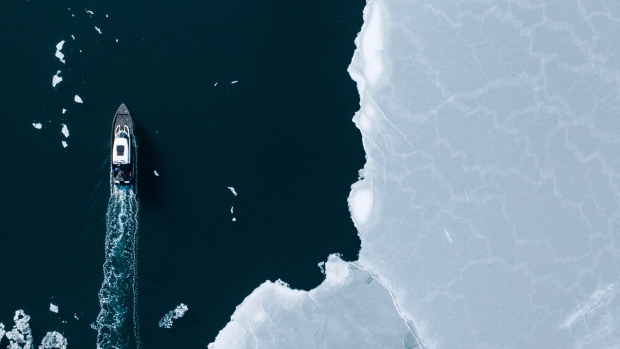Apr 6, 2023
The Arctic’s Peak Ice Cover Has Shrunk by an Area Larger Than Egypt
, Bloomberg News

(Bloomberg) -- Sea ice covered 5.64 million square miles of the Arctic Ocean at the ice’s peak extent this year in early March. That’s almost 400,000 square miles less than the median coverage level at other March peaks between 1981 and 2010, according to the National Snow & Ice Data Center at the University of Colorado Boulder. The reduction is equivalent to an area larger than Egypt.
This year’s maximum extent of Arctic ice was the fifth lowest since satellite records began in 1979. And since that record-keeping started, the average ice extent for the entire month of March has shrunk by an average of 15,000 square miles a year, representing a loss of 880,000 square miles — an area bigger than Greenland.
Read more: George Soros Sees Threat to ‘Survival of Civilization’ as Arctic Melts
Arctic winter ice typically covers the greatest expanse of ocean in March, after which it begins a slow melt over the spring and summer months, shrinking to its smallest area, or minimum extent, in September.
The lowest peak coverage occurred in 2017, when the ice extended over just 5.56 million square miles before beginning to shrink. Five of the lowest maximum extents have occurred since that year. The 10 lowest coverage years have all taken place since 2006.
The greatest amount of Arctic warming seems to be taking place on the Atlantic Ocean side of the Arctic Ocean near the Barents Sea, said Mark Serreze, director of the center. While the causes are still being studied, it appears that warm water from the Atlantic is playing a bigger role in ice melt, on top of the impact from a warming atmosphere. “It very much appears that this is because of a change in what the ocean circulation is doing,” Serreze said.
This year’s reversal from net freeze to net melt took place about six days earlier than the average from 1981 to 2012, but factors like wind can cause a fair amount of variability, he said. The data also can’t be used to predict how much the ice will shrink by September, since unpredictable summer weather patterns have the biggest impact on that.
However, the broader trend is clearly one of less ice, which has multiple, cascading effects.
Perhaps the biggest question is what the loss of Arctic ice means for weather patterns in the rest of the world. More than anything else, weather patterns are driven by the planet’s attempt to equalize temperature differences between higher and lower latitudes.
The fact that the Arctic is warming much more quickly than the rest of the planet is changing that temperature gradient. “If we do that, the atmosphere has to respond, in one way or another,” said Serreze.
Warmer, more open waters absorb heat that ice would reflect, accelerating the melting process, and also mean bigger waves that cause thermal and mechanical erosion of coastlines. Sea mammals that depend on ice are losing their habitat. The livelihoods of Indigenous communities, which hunt the animals and use the ice for transportation, are threatened. “The question becomes what level of adaptability is there,” said Serreze.
©2023 Bloomberg L.P.





